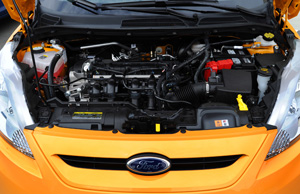
SAN FRANCISCO – Ford Motor Co.’s upcoming North American-spec Fiesta B-car shares 60% of its components with its global counterparts, while the new Focus C-car, debuting next year, is expected to have 80% parts commonality.
Sharing parts in all global markets leverages economies of scale and drives down costs, a key part of the auto maker’s “One Ford” strategy.
But anything beyond 80% commonality is a recipe for disaster, says Frank Davis, executive director-North America product development.
“If you start to commonize emissions systems and those sorts of things, it’s not the smartest way to do that or the most efficient way, from a cost perspective,” he tells Ward’s at a recent Fiesta launch event here.
“If you go to the most stringent (government) regulatory requirement, you’re adding cost into the vehicle in markets that don’t need that (low) of an emissions level,” he says. “And then you’ve got higher variable costs for the vehicle, which is going to affect your profitability.”
The new Fiesta was unable to hit that 80% mark because, unlike the upcoming Focus, it wasn’t conceived as a global vehicle from the onset. But future generations of the car will approach those upper limits, officials say.
Even with the lower percentage of shared parts, the Fiesta’s global commonality drives profitability both at Ford and its supply base, Davis says.
“This is a great opportunity for (suppliers) globally,” he says. “They’re excited about the volume opportunity, the commonality and the scale.”
In developing the North American Fiesta, Ford had the benefit of observing how the B-car faired with consumers in Europe, where it was launched in 2008, and in China, where it bowed in 2009.

Fiesta engineers were told to make only changes absolutely necessary for the North American market, an attempt by the auto maker to quell complaints its European models are superior to those sold on this side of the Atlantic.
“The way we looked at the program right from the start, we knew the key (changes) were for federalization,” says Steve Pintar, Fiesta chief program engineer. “It has to be legal, so we had to adopt Canadian and U.S. federal safety standards.”
For instance, U.S. regulations required a switch from single- to dual-stage airbags. Engineers also adjusted the bumper beams to meet requirements outlined by the U.S. and Canadian governments.
“The height (requirements) for the bumper beam and the coverage of the beam for low- and high-speed (collisions) is just different,” Pintar says. It’s not that one is better or one is worse.”
The emissions system had to be re-engineered to meet stringent U.S. and Canadian standards. Changes included recalibrating onboard powertrain diagnostics and reducing evaporative emissions, he says.
“There are completely different requirements,” Pintar says, citing the use of carbon canisters as an example. “They’re (used) in the U.S., not so in Europe.”
Ford’s ambitious plan to develop a line of global cars is not without precedent. Other auto makers, including Honda Motor Co. Ltd. with its Fit B-car, have implemented similar plans.
“We benchmarked the best of our competition that sell both in the U.S. and Europe, and we tried to not reinvent things,” Pintar says. “The parts we changed, (our competition) changed also.”
Consumer preferences also forced changes in the North American Fiesta. Among these modifications were the vehicle’s brakes. In Europe, consumers like “grabby” brakes, while in North America they prefer a softer feel, Pintar says.
“The rotors are the same, the calipers are the same and even the supplier, TRW (Automotive Holdings Corp.), is the same,” he says. “But in Europe, they go with much more aggressive semi-metallic linings that wear out faster.”
The linings also tend to produce excess brake dust and squealing. “In the U.S. you don’t want to launch a car with brake squeal,” Pintar says. “You’ll see it in dealership metrics.”
Europeans also are more apt to change from summer to winter tires, while Americans and Canadians prefer all-season tires.
To accommodate this preference, engineers had to retune the Fiesta’s electronic power-assisted steering system.
“This took a year and a half of dedicated tuning by the dynamics team,” Pintar says. “We took it to heart. We didn’t want people to come out and say ‘Why did you slow the car down, why does it feel sluggish?’ It had to feel crisp and sharp like the European car.”
Other changes made to accommodate North American consumer preferences include adding more cupholders and changing the seat reclining system from a rotary type to a lever.
Meanwhile, Davis says Ford’s Cuautitlan, Mexico plant, where the Fiesta will be built, has been “revitalized.”
Formerly a truck plant that produced older model F-Series pickups, the facility has been completely retooled and a new stamping plant has been added.
Ford largely turned over the facility’s workforce, hiring in “new, highly educated” personnel, Davis says.
“The Cuautitlan plant is up and running right now. We’re doing pre-production builds and it’s going well,” he says.
The plant is operating on one shift, but Ford plans on adding a second shift.



